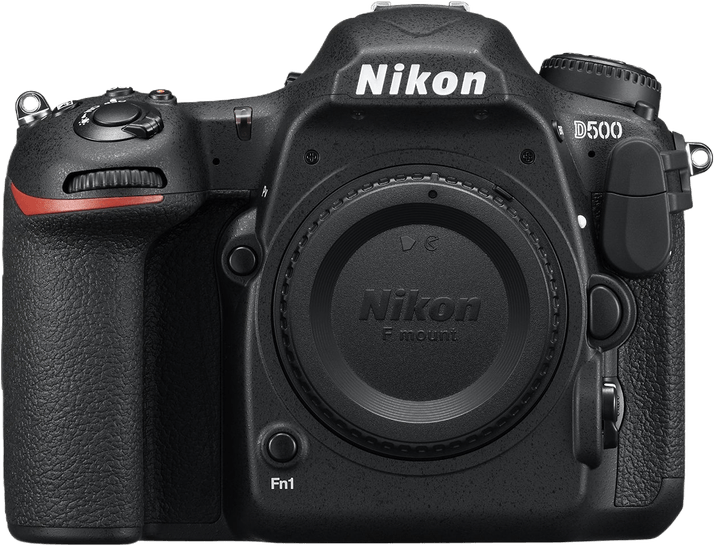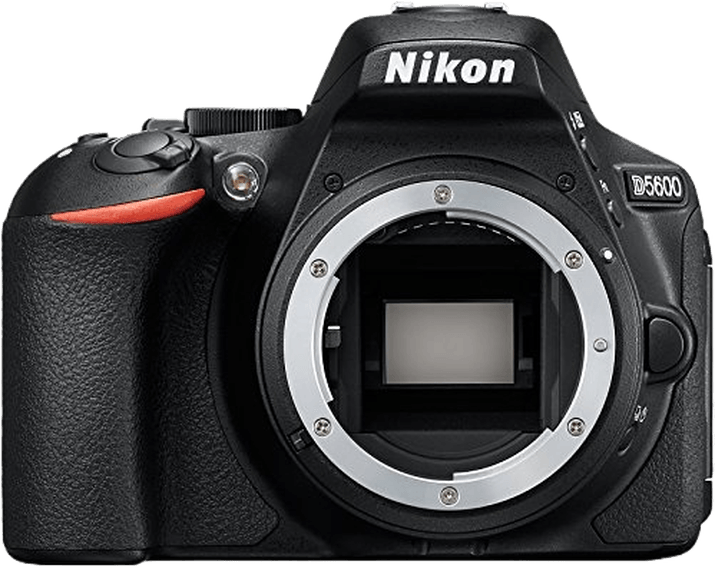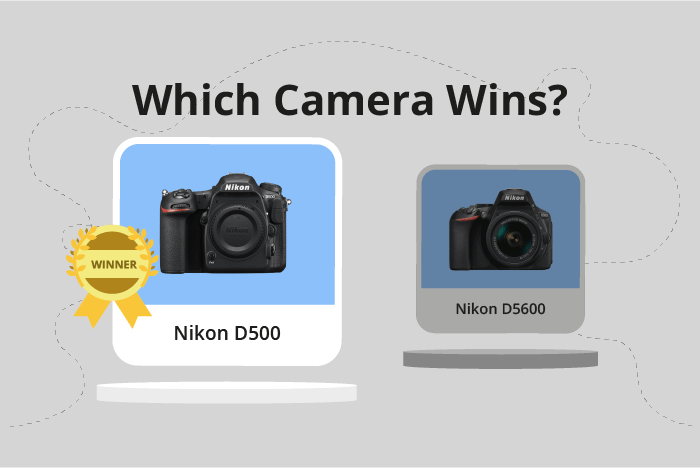Nikon D500 vs D5600 Comparison
Nikon D500

Nikon D5600

The Nikon D500 emerges as the winner with a score of 75/100, while the Nikon D5600 trails behind at 66/100. Both cameras are DSLRs launched in 2016, with the D500 announced on January 6th and the D5600 on November 10th. They share similarities in camera type and release year.
The D500 outperforms the D5600 with its higher score, larger size (147 x 115 x 81mm), and heavier weight (860g / 1.90lbs). However, the D5600 does have its advantages: it has a significantly lower launch price of $700 compared to the D500’s $2000, and it is also lighter and more compact at 124 x 97 x 70mm and 465g / 1.03lbs.
Taking these factors into account, the Nikon D500 is the superior camera in terms of performance, while the D5600 offers a more budget-friendly and portable option for photographers.
Nikon D500 vs D5600 Overview and Optics
The Nikon D500 comes out on top with an optics score of 69/100, while the Nikon D5600 scores slightly lower at 65/100. Both cameras share several specifications, such as their CMOS sensor type, APS-C sensor size, Nikon F DX lens mount, and lack of image stabilization. They also have the same DXOMARK score for their sensors at 84.
The Nikon D500’s superior optics can be attributed to its higher shooting speed of 10 frames per second, compared to the D5600’s 5 frames per second. This allows the D500 to capture fast-moving subjects with ease. Additionally, the D500 has a more advanced processor, the Expeed 5, which contributes to better image processing and overall performance.
On the other hand, the Nikon D5600 has a higher megapixel count at 24.2, compared to the D500’s 20.9 megapixels. This allows the D5600 to capture images with greater detail and resolution. However, this advantage may not be significant for most users, as the difference in megapixels is relatively small.
While the Nikon D500’s faster shooting speed and more advanced processor make it the better camera in terms of optics, the Nikon D5600’s higher megapixel count offers an advantage in capturing more detailed images. Ultimately, the choice between these two cameras will depend on the user’s specific needs and preferences. If capturing fast-moving subjects is a priority, the D500 is the better option. However, if the user values higher resolution images, the D5600 may be the more suitable choice.
Nikon D500 vs D5600 Video Performance
The Nikon D500 and the Nikon D5600 both have a video score of 70/100. These cameras share some specifications, such as having time-lapse functionality built-in. However, there are differences between the two in terms of video capabilities.
The Nikon D500 offers better video quality with its maximum video resolution of 4K (3840 x 2160) compared to the D5600’s Full HD (1920 x 1080) resolution. This higher resolution provides more detail and clarity in the recorded videos. Additionally, the D500 has a maximum video frame rate of 30fps, which is sufficient for most shooting scenarios.
On the other hand, the Nikon D5600 has a higher maximum video frame rate of 60fps, allowing for smoother video playback and better slow-motion effects. This advantage might appeal to users who prioritize capturing fast-moving subjects in their videos. However, the D5600’s lower video resolution might not provide the same level of detail as the D500’s 4K resolution.
In comparing the video capabilities of the Nikon D500 and the Nikon D5600, both cameras have their strengths and weaknesses. The D500 has a clear advantage in terms of video resolution, while the D5600 offers a higher frame rate for smoother playback. Users should consider their specific video needs and preferences when choosing between these two cameras.
Nikon D500 vs D5600 Features and Benefits
The Nikon D500 emerges as the winner with a feature score of 87/100, while the Nikon D5600 trails behind with a score of 72/100. Both cameras share several common specifications such as a 3.2-inch screen, touchscreen capabilities, flip screen, GPS, WIFI, and Bluetooth connectivity.
The Nikon D500 outperforms the D5600 in terms of screen resolution, boasting a significantly higher resolution of 2,359,000 dots compared to the D5600’s 1,037,000 dots. This higher resolution allows users to have a clearer and more detailed view of their images, enhancing their photography experience.
While the Nikon D5600 does not surpass the D500 in any particular specification, it still holds its ground with a respectable feature score of 72/100. The D5600’s shared features with the D500, such as the touchscreen, flip screen, and connectivity options, make it a viable option for those seeking a reliable camera.
Considering the individual specifications and overall feature scores, the Nikon D500 is the superior choice due to its higher resolution screen. However, the Nikon D5600 remains a solid option for those who value the shared features between both cameras. Ultimately, the decision will depend on the user’s specific needs and preferences, with the D500 being the better choice for those prioritizing screen resolution.
Nikon D500 vs D5600 Storage and Battery
The Nikon D500 outperforms the Nikon D5600 in storage and battery, scoring 79/100 compared to the D5600’s 43/100. Both cameras share some specifications, such as the lack of USB charging and the compatibility with SD, SDHC, and SDXC memory cards. However, the D500 accepts UHS-II cards, while the D5600 only supports UHS-I cards.
Additionally, the D500 has two memory card slots, offering more storage and flexibility compared to the D5600’s single slot. The D500 also boasts a longer battery life, with 1240 shots per charge using the EN-EL15 battery, while the D5600 manages 970 shots with its EN-EL14a battery.
The D5600 does not have any advantages in storage and battery over the D500. Therefore, the D500 is the superior choice in this aspect, offering greater storage capacity and longer battery life for photographers who require these features.
Nikon D500 vs D5600 – Our Verdict
Are you still undecided about which camera is right for you? Have a look at these popular comparisons that feature the Nikon D500 or the Nikon D5600:

